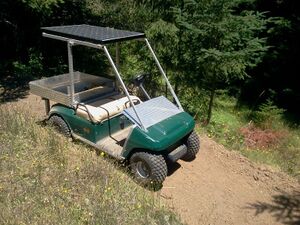Golf carts: Difference between revisions
From
No edit summary |
No edit summary |
||
| (3 intermediate revisions by the same user not shown) | |||
| Line 1: | Line 1: | ||
{{Projects infobox | {{Projects infobox | ||
|image = 66097878 1400805993422314 1535320129645051904 n.jpg | |image = 66097878 1400805993422314 1535320129645051904 n.jpg | ||
| | |designers = | ||
|date = | |date = | ||
|vitamins = | |vitamins = | ||
| Line 8: | Line 8: | ||
|lifecycles = | |lifecycles = | ||
|tools = [[Wrenches]] | |tools = [[Wrenches]] | ||
|parts = [[Frames]], [[Nuts]], [[Bolts]] | |parts = [[Frames]], [[Nuts]], [[Bolts]], [[Solar panels]], [[Wheels]], [[Keyed shafts]], [[Wheel hubs]], [[Shaft collars]], [[Keys]], [[Axial bearings]] | ||
|techniques = [[Tri joints]], [[Triangles]] | |techniques = [[Tri joints]], [[Triangles]], [[Wheels and axles]] | ||
| | |files = | ||
|suppliers = | |||
|git = | |git = | ||
}} | }} | ||
Latest revision as of 08:34, 23 September 2021
Project: Golf carts
| Tools: | Wrenches |
|---|---|
| Parts: | Frames, Nuts, Bolts, Solar panels, Wheels, Keyed shafts, Wheel hubs, Shaft collars, Keys, Axial bearings |
| Techniques: | Tri joints, Triangles, Wheels and axles |
Introduction
A golf cart (called golf car in ANSI standard Z130.1, since "carts" are not self-propelled) is a small vehicle designed originally to carry two golfers and their golf clubs around a golf course or on desert trails with less effort than walking.
Golf carts come in a wide range of formats such as 2, 4, and 6 seaters and are more generally used to convey small numbers of passengers short distances at speeds less than 15 mph (24 km/h) per ANSI Standard z130.1 as originally manufactured. They are generally around 4 feet (1.2 m) wide × 8 feet (2.4 m) long × 6 feet (1.8 m) high and weigh 900 pounds (410 kg) to 1,000 pounds (450 kg). Most are powered by 4-stroke engines.
